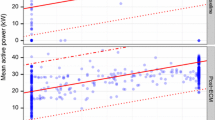Abstract
In this study, we explore the effectiveness of a hybrid modelling approach that seamlessly integrates data-driven techniques, specifically Machine Learning (ML), with physics-based equations in Simulation. In cases where real-world data for industrial processes is insufficient, a simulation tool is employed to generate an extensive dataset of process variables under varying operating conditions. Subsequently, this dataset is utilized for training the Machine Learning model. The paper showcases a practical use case of this hybrid modelling approach, revealing a model that consistently demonstrates strong predictive accuracy and reliability within the specific industrial context we investigate. By merging the insights derived from physics-based understanding with the adaptability of data-driven Machine Learning, the hybrid model offers a comprehensive solution for precise and accurate predictions.
Access this chapter
Tax calculation will be finalised at checkout
Purchases are for personal use only
Similar content being viewed by others
References
Rueden, L., Mayer, S., Sifa, R., Bauckhage, C., Garcke, J.: Combining machine learning and simulation to a hybrid modelling approach: current and future directions. In: Advances In Intelligent Data Analysis XVIII, pp. 548–560 (2020)
Liao, L., Köttig, F.: A hybrid framework combining data-driven and model-based methods for system remaining useful life prediction. Appl. Soft Comput. 44, 191–199 (2016)
Erge, O., Oort, E.: Combining physics-based and data-driven modelling in well construction: hybrid fluid dynamics modelling. J. Nat. Gas Sci. Eng. 97, 104348 (2022). https://www.sciencedirect.com/science/article/pii/S1875510021005436
Song, H., Liu, X., Song, M.: Comparative study of data-driven and model-driven approaches in prediction of nuclear power plants operating parameters. Appl. Energy 341, 121077 (2023). https://www.sciencedirect.com/science/article/pii/S0306261923004415
Zhang, S., et al.: Combing data-driven and model-driven methods for high proportion renewable energy distribution network reliability evaluation. Int. J. Electr. Power Energy Syst. 149, 108941 (2023). https://www.sciencedirect.com/science/article/pii/S0142061522009371
Michaud, L.: Froth Flotation: A Century of Innovation (2017). https://www.911metallurgist.com/blog/froth-flotation-century-innovation
Bendaouia, A., et al.: Digital transformation of the flotation monitoring towards an online analyzer. In: Hamlich, M., Bellatreche, L., Siadat, A., Ventura, S. (eds.) SADASC 2022. Communications in Computer and Information Science, vol. 1677, pp. 325–338. Springer, Cham (2022). https://doi.org/10.1007/978-3-031-20490-6_26
Hasidi, O., et al.: Digital Twins-Based Smart Monitoring and Optimisation of Mineral Processing Industry. In: Hamlich, M., Bellatreche, L., Siadat, A., Ventura, S. (eds.) SADASC 2022. Communications in Computer and Information Science, vol. 1677, pp. 411–424. Springer, Cham (2022). https://doi.org/10.1007/978-3-031-20490-6_33
Roine, A.: HSC Chemistry® [Software], Metso Outotec, Pori (2021). Software available at www.mogroup.com/hsc
Sircar, A., Nair, A., Bist, N., Yadav, K.: Digital Twin in hydrocarbon industry. Petrol. Res. (2022)
Qassimi, S., Abdelwahed, E.H.: Disruptive innovation in mining industry 4.0. Distrib. Sens. Intell. Syst. 313–325 (2022)
Acknowledgements
This work is supported by the Ministry of Higher Education, Scientific Research and Innovation, the Digital Development Agency (DDA) and the CNRST of Morocco through Al-Khawarizmi program. This publication is part of the work undertaken by the consortium of partners which is composed of MAScIR (Moroccan Foundation for Advanced Science, Innovation and Research), Reminex; the R &D and Engineering subsidiary of Managem group, UCA, ENSIAS and ENSMR. We would like to thank the Managem Group and its subsidiary CMG for allowing the conduction of this research on its operational site as an industrial partner of this project.
Author information
Authors and Affiliations
Corresponding author
Editor information
Editors and Affiliations
Rights and permissions
Copyright information
© 2024 The Author(s), under exclusive license to Springer Nature Switzerland AG
About this paper
Cite this paper
Hasidi, O. et al. (2024). Data-Driven and Model-Driven Approaches in Predictive Modelling for Operational Efficiency: Mining Industry Use Case. In: Mosbah, M., Kechadi, T., Bellatreche, L., Gargouri, F. (eds) Model and Data Engineering. MEDI 2023. Lecture Notes in Computer Science, vol 14396. Springer, Cham. https://doi.org/10.1007/978-3-031-49333-1_9
Download citation
DOI: https://doi.org/10.1007/978-3-031-49333-1_9
Published:
Publisher Name: Springer, Cham
Print ISBN: 978-3-031-49332-4
Online ISBN: 978-3-031-49333-1
eBook Packages: Computer ScienceComputer Science (R0)




